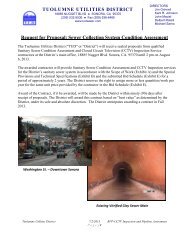Historic Resource Evaluation Project - Tuolumne Utilities District
Historic Resource Evaluation Project - Tuolumne Utilities District
Historic Resource Evaluation Project - Tuolumne Utilities District
You also want an ePaper? Increase the reach of your titles
YUMPU automatically turns print PDFs into web optimized ePapers that Google loves.
Roach’s Camp Ditch<br />
The Roach’s Camp Ditch was constructed to take water from Turnback Creek to Roach’s<br />
Camp south of <strong>Tuolumne</strong> on Ward’s Ferry Road, located near the top of the grade above<br />
the <strong>Tuolumne</strong> River (Gudde 1975:293). The ditch was evidently built sometime after<br />
1855, as when the camp was visited that year it was described as one of several small but<br />
promising camps located southeast of Sonora, and that as soon as they could get a good<br />
supply of water for the entire season they would be able to get a good amount of gold<br />
(Heckendorn and Wilson 1856:89). There is little mention of Roach’s Camp in the<br />
literature, but brief accounts of people still residing there were noted in the 1860s and<br />
1870s (Lang 1882:236, 296).<br />
Sometime in the late 1880s or early 1890s, it was connected to the TCWC Main Ditch via<br />
the Section 4 and Eureka ditches at the <strong>Tuolumne</strong> Reservoir and extended southerly to<br />
the Roach’s Camp Reservoir where it branched two ways to the Ajax and Free Lance<br />
hard rock mines. The ditch was described as having been constructed about 1890 to<br />
supply the mining region about Roach’s Camp and Poison Oak Gulch, so it appears likely<br />
that the original 1850s-1860s Roach’s Camp Ditch was rebuilt by the TCWC at that time<br />
to supply the hard rock mines that had recently opened (Rhodin 1916). The <strong>Tuolumne</strong><br />
<strong>Utilities</strong> <strong>District</strong> now refers to it as the Camp Roach Ditch.<br />
END OF THE BOOM<br />
Though essential to the development of mineral resources, related attendant industries<br />
such as steam- or water-powered sawmills, and the commercial establishments and towns<br />
that grew up in the county, the prosperity of the water system was ending by the late<br />
1860s due to the general decline in mining. In 1866 the TCWC, however, was still<br />
making a profit, paying $35,750 in dividends to stockholders (Browne 1869:194). That<br />
year was also an auspicious one for the future of the TCWC, as on July 26, 1866, the<br />
right of ingress to and egress from the ditch, as well as the right to clean, maintain and<br />
repair it, was granted by the United States Congress under an act entitled “An Act<br />
Granting the Right-of-Way to Ditch and Canal Owners over the Public Lands and for<br />
Other Purposes” (Faulstich 1985).<br />
With the Act guaranteeing its continued operations, water continued to be delivered to<br />
agricultural users, especially the truck gardens and apple orchards, as well as some<br />
mining ventures. Writing in the 1880s, Herbert O. Lang described the decline:<br />
…by the end of the sixties but few placer claims were worked with good<br />
results; the enterprising gold-seekers had sought more productive fields.<br />
With the departure of the miners came dull times for the camps…The<br />
store and saloons, no longer crowded with customers, put up their shutters<br />
and retired from a business no longer profitable… Ditches and flumes<br />
were suffered to go to ruin…By the close of the next decade the<br />
resounding crash of the stamp mill had well nigh ceased, and now, in<br />
Foothill <strong>Resource</strong>s, Ltd. 3.28 TUD Ditch Sustainability <strong>Project</strong><br />
Francis Heritage, LLC<br />
<strong>Historic</strong> <strong>Resource</strong> <strong>Evaluation</strong> Report




